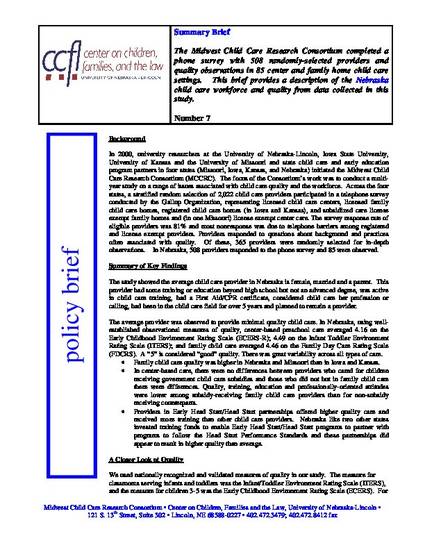
The study showed the average child care provider in Nebraska is female, married and a parent. This provider had some training or education beyond high school but not an advanced degree, was active in child care training, had a First Aid/CPR certificate, considered child care her profession or calling, had been in the child care field for over 5 years and planned to remain a provider.
The average provider was observed to provide minimal quality child care. In Nebraska, using well-established observational measures of quality, center-based preschool care averaged 4.16 on the Early Childhood Environment Rating Scale (ECERS-R); 4.49 on the Infant Toddler Environment Rating Scale (ITERS); and family child care averaged 4.46 on the Family Day Care Rating Scale (FDCRS). A “5” is considered “good” quality. There was great variability across all types of care.
· Family child care quality was higher in Nebraska and Missouri than in Iowa and Kansas.
· In center-based care, there were no differences between providers who cared for children receiving government child care subsidies and those who did not but in family child care there were differences. Quality, training, education and professionally-oriented attitudes were lower among subsidy-receiving family child care providers than for non-subsidy receiving counterparts.
· Providers in Early Head Start/Head Start partnerships offered higher quality care and received more training than other child care providers. Nebraska like two other states invested training funds to enable Early Head Start/Head Start programs to partner with programs to follow the Head Start Performance Standards and these partnerships did appear to result in higher quality than average.
Available at: http://works.bepress.com/carla_peterson/3/

Published by Midwest Child Care Research Consortium • Center on Children, Families and the Law, University of Nebraska-Lincoln • 121 S. 13th Street, Suite 302 • Lincoln, NE 68588-0227 • 402.472.3479; 402.472.8412 fax